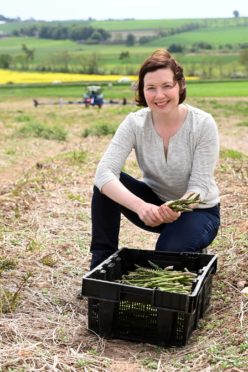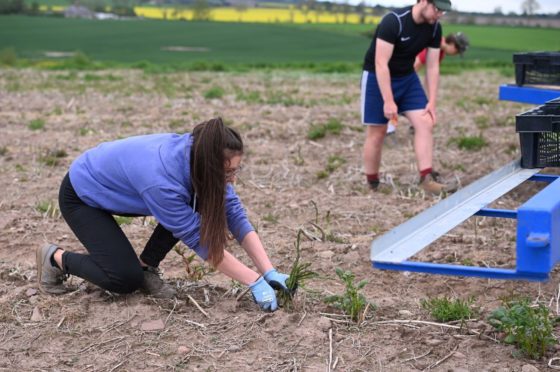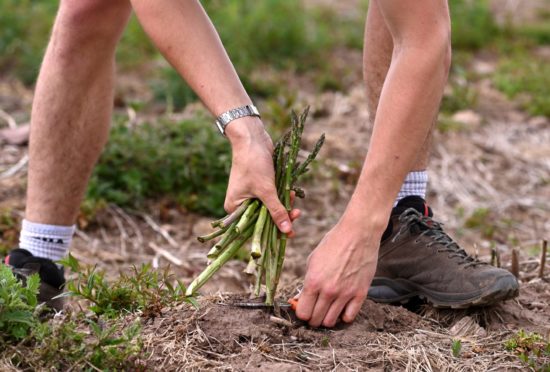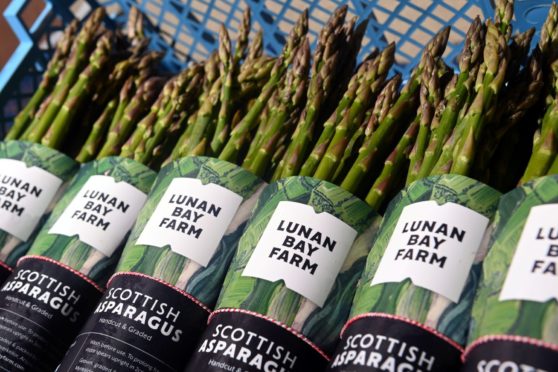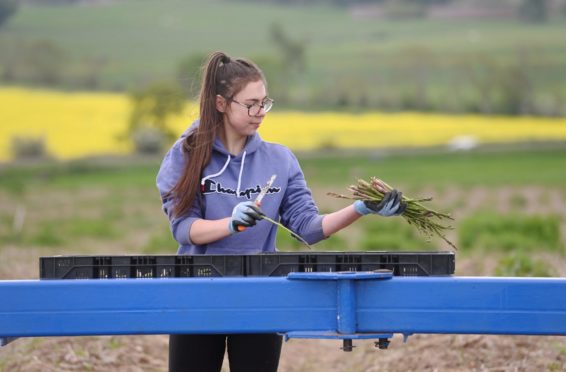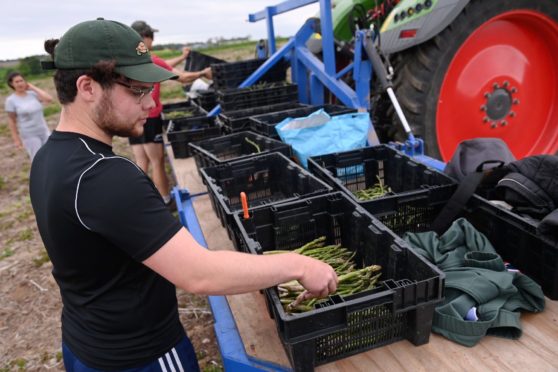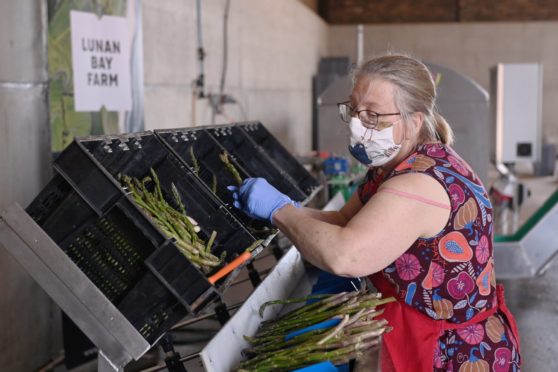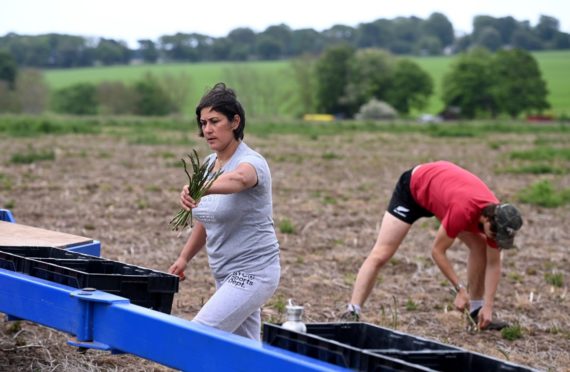It has been all hands to the pump to pick Lunan Bay Farm asparagus after poor May weather saw a slow start to the harvest. Brian Stormont visited to see how they were doing.
The last few weeks have been busy at Lunan Bay Farm with workers hard at it to hand pick the asparagus crop after the unseasonal weather delayed the start of the season.
Lunan Bay Farm asparagus is highly sought after, so for Jillian and Neil McEwan, it was disappointing that one of the worst Mays on record hampered the operation.
However, they finally got to harvest their crop in time to send it out to chefs, farm shops and delicatessens who eagerly wait for the short six-week season every year.
And while there are hungry people all over the country now enjoying their asparagus, there are also incredible environmental positives of growing asparagus with wildlife benefiting from the crop.
Endangered species of birds, in particular, find asparagus fields the ideal habitat to raise their young safely, so that is an added bonus.
Finally picking asparagus
There are few growers of the crop north of the border but Lunan Bay Farm asparagus is now in its fifth year.
Jillian said they were delighted to have the team of pickers out in the field after the disappointingly cold weather conditions last month.
“It’s been a long wait but we are finally out there freshly cutting our asparagus,” she said.
“It’s a six-week season in Scotland for asparagus and you have to cut your asparagus every day, the crop continually keeps growing and you require eight degrees temperature across a 24-hour period for growth to happen.
“The conditions we have been having in the last week – we have been getting up to 18 degrees, so what we are seeing is asparagus getting cut in the morning, you are finishing one side of the field and then you have to go back and cut that first lot of asparagus again.
“It can grow really quickly under the right conditions. Unfortunately, May was one of the worst on record weather-wise. It was very cold and the asparagus just did not appear because of that reason.”
‘Labour of love’
Harvesting asparagus is extremely labour intensive and back-breaking stuff for the pickers, as it all must be done by hand.
And the fresh asparagus is delivered to the eager customers within 24 hours of having been picked.
Jillian explained: “So it’s all freshly hand-cut, there is no machine that can cut asparagus, so it truly is a labour of love.
“We hand-cut it fresh every morning and it is taken to our on-site pack house on the farm where it is washed, trimmed and graded into the different thicknesses of spears.
“We package it all up with our brand labels and it is sent out that afternoon to our local customers or the next morning to our customers further afield in Glasgow, Edinburgh and Fife.”
Reacting to coronavirus pandemic
The Lunan Bay Farm asparagus has proved extremely popular since they began producing it, particularly with chefs up and down the country keen to plate up the finest Scottish produce.
But the coronavirus pandemic last year resulted in a change of thinking regarding distribution.
“Last year Covid hit just before the harvest started. Every spear had been earmarked for chefs and was pre-sold, then in the week before all the restaurants were forced to close because of Covid and we had to quickly had to find a new market,” Jillian revealed.
“Luckily we worked with lots of small independent retailers who really supported us, and there were lots of people who had home delivery services and veg boxes.
“We went from having an issue of wondering where our asparagus was going to go to wondering how we would keep up with demand.”
‘Regenerative agriculture’
And there are many associated benefits with farming asparagus, such as the positive effect it has on habitats of some endangered wildlife.
Jillian continued: “For us, it’s all about regenerative agriculture and we have adopted these principles in order to support the biodiversity on the farm.
“What was really fascinating for us when we planted our asparagus was we discovered that as it’s a long-term perennial, the crops remain in the ground for up to 10 years which is very unusual because most commercially-grown crops, such as barley and wheat are annuals.
“What this does is that it creates a stable habitat for wildlife and we soon discovered that species are that are endangered such as lapwings and skylarks started to nest on the field.
“We have actually got several colonies that nest here because there is no vegetation so the mums can see if there any predators while they are nesting
“In the summertime, the spears turn into ferns so the ferns can be up to a metre high or a metre or two wide which is the perfect coverage for the chicks. It’s good fun to watch the development of the eggs into chicks.”
Having seen the amazing benefits to the environment and the wildlife, Jillian and Neil began exploring other avenues.
Jillian added: “Those successes really spurred us on to look at other nature-friendly practices we could do.
“My husband, Neil, has been involved in corn bunting land management scheme with the RSPB that’s to create more habitats for another endangered bird in the area and I am pleased to say that surveys have been done annually and the population is beginning to increase.
“Likewise, we are working alongside the Woodland Trust charity and in December we planted 4,000 trees and hedgerows to put in a natural barrier to protect our crops, specifically the asparagus, but also to create new habitat for other birds we want to help, including grey partridges. We have seen up to about 30 colonies now which is great.
“All of our projects are to improve the soil health on the farm and that is why we also have 350 goats because they help to fertilise the soil naturally.”
Sunday funday grading asparagus in the packhouse. Spear quality is amazing after all the sunshine. #spearsofglory #lunanbayasparagus #scottishasparagus pic.twitter.com/7QyA2AOUCS
— Lunan Bay Farm (@LunanBayFarm) June 13, 2021
500 bunches of Lunan Bay Farm asparagus
So, when harvesting, what yield do they expect to attain with the Lunan Bay Farm asparagus and how do you cook it?
“Ideally, we are looking for about 500 bunches a day, we have seen that in the last few years,” said Jillian.
“This year we were slow to start, so we are probably just under that. We don’t grow in polytunnels, everything is grown in the open so we are very much at the mercy of the Scottish weather.
“We love asparagus. The simplest way of cooking it is always the best. With great quality produce you don’t need to mess about it.
“I like to pan fry it with a little bit of butter, a squeeze of lemon, some sea salt and maybe some Hollandaise if I am feeling luxurious. The simpler the better.
“It is such a versatile vegetable, you can eat asparagus for breakfast, lunch or dinner, and you can barbecue it in the summer. Thicker spears are amazing on the grill.
“We produce a wonky grade, which again is part of our ethos of avoiding food waste, and throwing some of the wonky spears into risotto is amazing!
“And any other waste from the ends of the asparagus that are trimmed off in the grader, they are all fed back to the goats so it is a whole circular process of reducing our food waste.”
Read more about local produce…
Season’s Eatings: spear a thought for asparagus as the green stuff sprouts into shops near you
